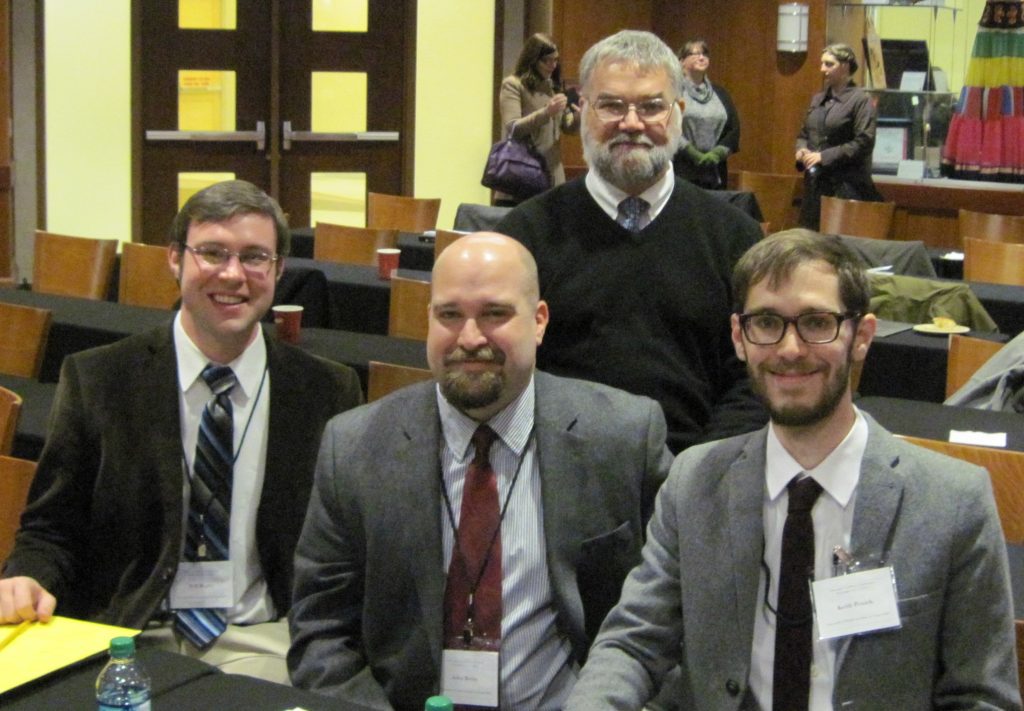In fall 2013, Robert Babcock presented his Latin paleography graduate students with a challenge. He asked three of his students to determine the origins of a collection of over fifty eleventh-century manuscripts from the Belgian Royal Library. This neglected area of research would entail painstakingly analyzing the script, the corrections, and the marginalia of the hand-scribed documents to determine whether or not they were originally copied at the Gembloux abbey. Will Begley, John Beeby, and Keith Penich accepted the challenge and altered the way scholars understand this important collection. By identifying the origins of the manuscripts, Begley, Beeby, and Penich placed these texts in their rightful context, and went on to share their groundbreaking findings at a paleographic conference.
The valued collection of manuscripts came to Brussels in the eighteenth century from the nearby abbey of Gembloux, and contain several classical, patristic, and medieval texts, including Cicero, Lucan, Manilius, and Ovid. While textual scholars have long treasured the contents of the documents, the context of the creation of the manuscripts remained unknown. Paleographers were uncertain whether or not the manuscripts had originally been copied at the abbey or had been acquired by the abbey from elsewhere.

This is where Begley, Beeby, and Penich stepped in to assist Prof. Babcock and his Belgian colleague, Albert Derolez, with their comprehensive study of the collection.
The three each focused on a different aspect of the manuscripts — the script, the corrections, and the critical signs — to determine that the manuscripts did originate with the abbey. Deciphering the script, Penich analyzed the eleventh-century copy of Statius’ Thebaid and Achilleid. He compared the scribal hands of the collection to determine that the scribal hand of the Statius works matched that of one belonging to the abbey. Next, Beeby compared the scribal and correcting hands of Valerius Maximus to other manuscripts from Gembloux, finding that both hands were evident in many different Gembloux texts. Finally, Begley examined the system of critical signs, or marginalia, used in the Gembloux scriptorium in the eleventh and twelfth centuries. Examining primarily Cicero’s Tusculan Disputations, he revealed how the Tusculans and other texts were read and understood by the Gembloux community.
Begley, Beeby, and Penich then translated their final papers for the course into a panel discussion at the Text and Contexts November 2014 conference at The Ohio State University. There, the academic community took note of their laborious study.
“The papers were brilliant. The manuscripts are all of prime importance for the editor of these texts, and each man had something new to say about his own,” exclaimed the conference’s keynote speaker, Francis Newton, PhD ’53, in an email after the conference.
“The UNC panel was widely described as one of the highlights of the conference,” Prof. Babcock, who chaired the session, reflected. “Our graduate students were praised for the quality, originality, and importance of their work, as well as for the clarity and organization of their presentations.”
“To me, a long-time student of Latin manuscripts and texts, it was fascinating and ground-breaking. The audience felt the same way,” continued Prof. Newton. “The presentation was professional, though I am happy to report that each also, at some point, let us see how enthusiastic he was about his project and his finds.”